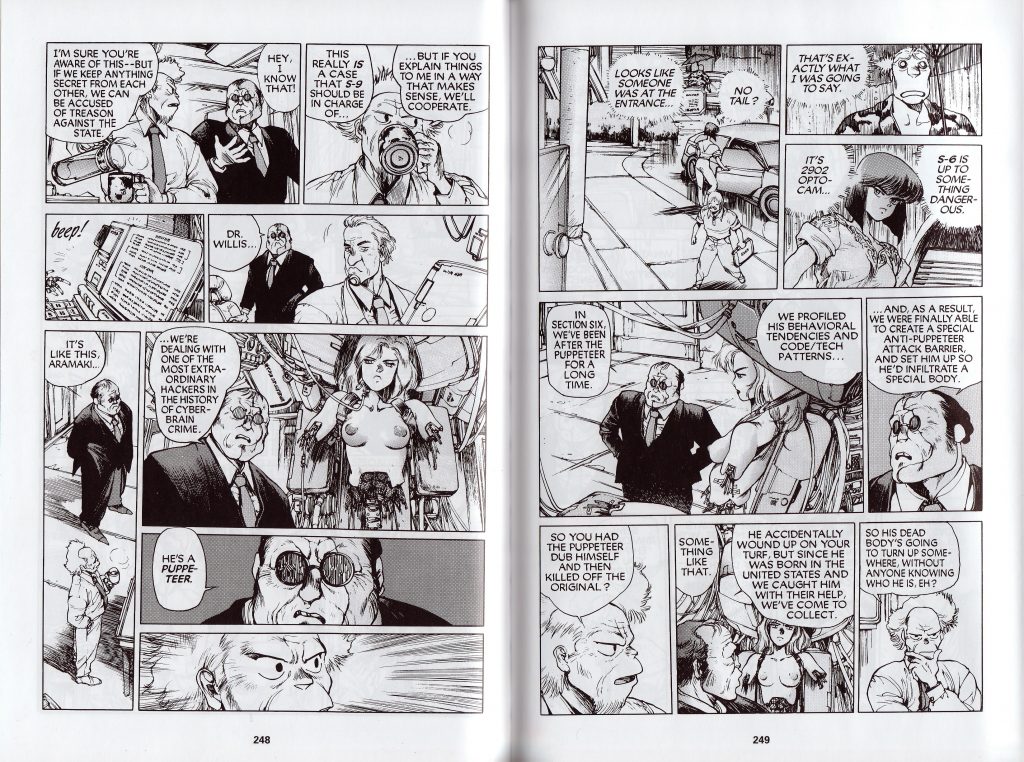Ghost in the Shell
While I’ve been reading comics for a while now, I’ve long struggled to get into the other side of the graphic novel world: manga (and paired with it, anime). It’s a style that I’ve not developed a taste for and frankly, an entire culture in and of itself that has long gone over my head. I don’t hold with criticizing something you have no experience with but I have tended to avoid manga in the past for a myriad of reasons that largely have to do with not being a fan of the way that characters and emotions are drawn. But as a reader and a reviewer of graphic novels, I feel that it’s a part of that world that I don’t (and would like to) understand and appreciate. In an effort to branch out and maybe challenge my assumptions, and since the movie will be out tomorrow, I decided to take a look at a manga that is often seen as a classic, must-read story: Ghost in the Shell. Written and illustrated by Masamune Shirow, Ghost in the Shell is comprised of several volumes. The first was published from 1989-1990 and is the core story. A sequel, Man-Machine Interface, was published from 1991-1997 and followed by a series of a few extra stories, Human-Error Processor, which was published in 2003. Since I had no prevous experience with the series, I chose to stick with the first volume as it formed the core of the manga story and was known was the must-read portion of the series.
Ghost in the Shell follows the exploits of cyborg Major Motoko Kusanagi, who heads the counter-terrorism unit known as Sector 9 in mid-21st century Japan. The setting is solidly cyberpunk with a dystopian, more militarized Japan that has seen the integration of all kinds of tech and to whom cyborgs and robots are both common place and necessary. Major and her team, under Chief Daisuke Aramaki, are charged with insuring that corporations and citizens follow the rules concerning both robots and humans and everyone in between and dealing with a great deal of international intrigue and corporate espionage. By far their greatest challenge is a cybercriminal by the name of the Puppeteer who commits crimes via ghost-hacking into people’s brains. Major and the team must handle all the internal politics as well as the challenge of the Puppeteer if they want to ensure their own survival and that of Sector 9.
The Ghost in the Shell manga has a reputation for being significantly less accessible than either the anime or movies that followed and it is well deserved. I’m a fan of the cyberpunk genre and have been since picking up William Gibson’s Neuromancer after playing the new-ish Android: Netrunner card game. Many of the elements of Gibson’s writing are present here and it can be just as difficult to read. Both Gibson and Shirow have a tendency for dense, technical writing filled with detailed systems and technologies that they almost never bother to explain. Both authors expect readers to figure it out as they go and neither is inclined to hold your hand while you do so. This makes reading both challenging and occasionally, very frustrating. Adding in the tendency to have women be permanently half or completely naked for reasons that really don’t hold water with me and I will admit that I neither liked nor understood the first few issues of Ghost in the Shell. However, the setting and the mystery of the various cybercriminal cases were intriguing enough to keep me reading and the series gets substantially better as it goes. Major is a very interesting character as she’s far from morally pure and has a tendency towards aloofness and superiority that is as off-putting as it is intriguing. Shirow has a tendency to go off on technical/scientific tangents that are barely comprehensible to someone as not science oriented as myself and about as interesting as a textbook. It’s a rough balance at times. But it has plenty of action and intrigue to catch your attention and the questions Shirow poses about the line between robot and human, where rights should end for one or the other and questions about how each treats the other are all immensely compelling and fascinating ones. It kept me reading despite myself.
The art is….alright, I guess. As I mentioned at the beginning of this review, I’m not a big fan of manga. As far as the traditional ways in which emotions and reactions are drawn, this was definitely on the more tolerable side of the spectrum. I do still get frustrated with women constantly being in bikinis but many of the women, especially the Major, are not exactly wilting flowers and I very much admired the characterization of them. Much of the story is in black and white with only a few pages at the beginning of most of the issues that are in color. Shirow does do a pretty good job of making the lack of color not matter in terms of enjoying the story.
While it’s tough for me to recommend Ghost in the Shell to everyone, I do agree that it’s a fantastic cyberpunk stories and well worth your time even if you’re as little of a manga fan as myself. It was a challenging read but well worth it and I’ll certainly try to add more manga to my reading list so that I can appreciate it as I do the Western style of comic. I’m not sure how the movie will translate this story but I look forward to finding out! And keep an eye out for a new Graphic Reviews segment which will examine movie adaptations and the source material, coming soon!
– Cait



